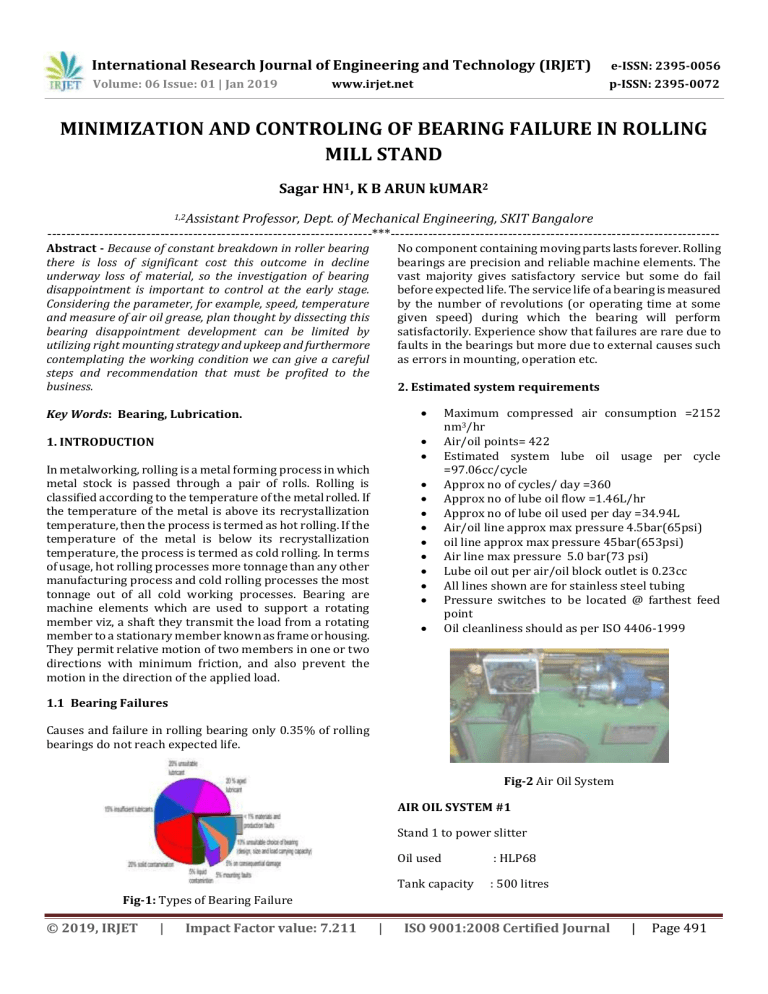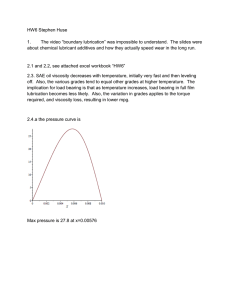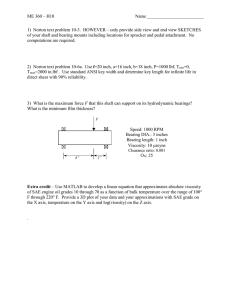IRJET-Minimization and Controling of Bearing Failure in Rolling Mill Stand
advertisement

International Research Journal of Engineering and Technology (IRJET) e-ISSN: 2395-0056 Volume: 06 Issue: 01 | Jan 2019 p-ISSN: 2395-0072 www.irjet.net MINIMIZATION AND CONTROLING OF BEARING FAILURE IN ROLLING MILL STAND Sagar HN1, K B ARUN kUMAR2 1,2Assistant Professor, Dept. of Mechanical Engineering, SKIT Bangalore ---------------------------------------------------------------------***---------------------------------------------------------------------- Abstract - Because of constant breakdown in roller bearing there is loss of significant cost this outcome in decline underway loss of material, so the investigation of bearing disappointment is important to control at the early stage. Considering the parameter, for example, speed, temperature and measure of air oil grease, plan thought by dissecting this bearing disappointment development can be limited by utilizing right mounting strategy and upkeep and furthermore contemplating the working condition we can give a careful steps and recommendation that must be profited to the business. No component containing moving parts lasts forever. Rolling bearings are precision and reliable machine elements. The vast majority gives satisfactory service but some do fail before expected life. The service life of a bearing is measured by the number of revolutions (or operating time at some given speed) during which the bearing will perform satisfactorily. Experience show that failures are rare due to faults in the bearings but more due to external causes such as errors in mounting, operation etc. 2. Estimated system requirements Key Words: Bearing, Lubrication. 1. INTRODUCTION In metalworking, rolling is a metal forming process in which metal stock is passed through a pair of rolls. Rolling is classified according to the temperature of the metal rolled. If the temperature of the metal is above its recrystallization temperature, then the process is termed as hot rolling. If the temperature of the metal is below its recrystallization temperature, the process is termed as cold rolling. In terms of usage, hot rolling processes more tonnage than any other manufacturing process and cold rolling processes the most tonnage out of all cold working processes. Bearing are machine elements which are used to support a rotating member viz, a shaft they transmit the load from a rotating member to a stationary member known as frame or housing. They permit relative motion of two members in one or two directions with minimum friction, and also prevent the motion in the direction of the applied load. Maximum compressed air consumption =2152 nm3/hr Air/oil points= 422 Estimated system lube oil usage per cycle =97.06cc/cycle Approx no of cycles/ day =360 Approx no of lube oil flow =1.46L/hr Approx no of lube oil used per day =34.94L Air/oil line approx max pressure 4.5bar(65psi) oil line approx max pressure 45bar(653psi) Air line max pressure 5.0 bar(73 psi) Lube oil out per air/oil block outlet is 0.23cc All lines shown are for stainless steel tubing Pressure switches to be located @ farthest feed point Oil cleanliness should as per ISO 4406-1999 1.1 Bearing Failures Causes and failure in rolling bearing only 0.35% of rolling bearings do not reach expected life. Fig-2 Air Oil System AIR OIL SYSTEM #1 Stand 1 to power slitter Oil used : HLP68 Tank capacity : 500 litres Fig-1: Types of Bearing Failure © 2019, IRJET | Impact Factor value: 7.211 | ISO 9001:2008 Certified Journal | Page 491 International Research Journal of Engineering and Technology (IRJET) e-ISSN: 2395-0056 Volume: 06 Issue: 01 | Jan 2019 p-ISSN: 2395-0072 Operating pressure : 45.5 bar Cycle time :on 90 sec 90sec www.irjet.net For 56 sec cycle on time Estimated system lube oil usage per cycle/cycle time on = 97.06cc/cycle/56 = 1.73 cc/sec Estimated system lube oil usage per cycle/cycle time off = 97.06cc/cycle/30 = 3.23 cc/sec 1.73 cc/sec = 0.00173×3600 = 6.288L/HR :off AIR OIL SYSTEM #2 AIR OIL SYSTEM #3 NTM-line A-pinch roller Cycle time on = 45sec line B-pinch roller Oil used Cycle time off = 90 sec : HLP68 Tank capacity Estimated system lube oil usage per cycle = 97.06cc/cycle : 500 litres For 45sec cycle on time Estimated system lube oil usage per cycle/cycle time on = 97.06cc/cycle/45=2.156 cc/sec Estimated system lube oil usage per cycle/cycle time off= 97.06cc/cycle/30=1.07 cc/sec 2.156 cc/sec=0.002156×3600= 7.7616L/HR Operating pressure : 45 bar Cycle time 120 sec :on 120sec :off AIR OIL SYSTEM #3 RES (rotary entry shear) Oil used Metering block : HLP68 Tank capacity Oil : 500 litres Fig -3 four outlet distributor block Operating pressure : 45 bar Cycle time Air & oil mixture As per present working conditions (for 16 stand) 120 sec :on 1 cycle=97.06cc=90 sec 120sec :off For 1 stand =6.06 cc Air oil system cycle time changes variations 1 distribution block=1.2cc AIR OIL SYSTEM #1 Pressure of air = 2 to 3 bar Cycle time on=75 sec 1 metering block volume capacity =230mm3=0.23 cc Cycle time off=120 sec 4 metering block volume capacity =920 mm3 =0.92cc 1hr=3600sec 2.1 Mode of operation: Estimated system lube oil usage per cycle =97.06cc/cycle For 75 sec cycle on time Estimated system lube oil usage per cycle/cycle time on = 97.06cc/cycle/75=1.29 cc/sec Estimated system lube oil usage per cycle/cycle time off = 97.06cc/cycle/120=0.80 cc/sec 1.29 cc/sec=0.00129×3600= 4.64L/HR The distributor leads the lubricant volumes supplied by the metering elements to the various outlets separately. Every outlet an air adjustment screw is assigned such screw enables the required compressed air volume to be adjusted Calculation required for oil AIR OIL SYSTEM #2 NH 20 bearing stand Cycle time on = 56sec NH-20(4 row cylinder bearing) Cycle time off = 30 sec ID=200mm, OD=270mm, width (B) =200 Estimated system lube oil usage per cycle = 97.06cc/cycle Q=W.d.B © 2019, IRJET | Impact Factor value: 7.211 | ISO 9001:2008 Certified Journal | Page 492 International Research Journal of Engineering and Technology (IRJET) e-ISSN: 2395-0056 Volume: 06 Issue: 01 | Jan 2019 p-ISSN: 2395-0072 www.irjet.net W=coefficient of friction D=bearing diameter in mm D=bearing diameter in mm B=bearing width in mm B=bearing width in mm Q=0.0018×280×220 Q=0.0018×200×200 Q=110mm3/hr =0.11016 cc/hr Q=72mm3/hr =0.072cc/hr Fig-6 NH-23(4 row cylinder bearing) Fig-4 NH-20(4 row cylinder bearing) Total number of stand=16 NH23 bearing stand Which consists of NH-20+ NH-23+ NH-28 NH-23(4 row cylinder bearing) (1-5) ID=230mm, OD=330mm, width (B)=206 (6-12) (13-16) =0.11016×5+0.08532×7+0.072×4 Q=W.d.B = .43× 10-6m3/hr W=coefficient of friction Oil consumption for horizontal and vertical shaft for a NH-20 D=bearing diameter in mm B=bearing width in mm Horizontal shaft Q=0.0018×230×206 Q=0.085DR/A Q=85.254mm3/hr D= stressed bearings =0.08532 cc/hr R= no of rows in one stand each contain four A=speed coefficient =0.085×200×16/0.719= 378.302× 10-6 m3/h Vertical shaft Q=0.17DR/A = 0.17×200×16/0.719= 756.606× 10-6 m3/h Oil consumption for horizontal and vertical shaft for a NH-23 Fig-5 NH-23(4 row cylinder bearing) Horizontal shaft NH 28 bearing stand NH-28(4 row cylinder bearing) Q=0.085DR/A = 0.085×230×16/0.784= 398.979× 10-6m3/h ID=280mm, OD=390mm, width (B)=220 Vertical shaft Q=W.d.B Q=0.17DR/A = 0.17×230×16/0.784=797.595× 10-6m3/h W=coefficient of friction Oil consumption for horizontal and vertical shaft for a NH-28 Horizontal shaft © 2019, IRJET | Impact Factor value: 7.211 | ISO 9001:2008 Certified Journal | Page 493 International Research Journal of Engineering and Technology (IRJET) e-ISSN: 2395-0056 Volume: 06 Issue: 01 | Jan 2019 p-ISSN: 2395-0072 www.irjet.net In rolling mills the load is of constant direction. Only a quarter of the outer race is under load. For this reason, the side face of the outer races are divided into four zones indicated by I to IV When the bearing is mounted for the first time it is usual to position zone I in the direction of action of load. After a period of approximately 1000 operating hours , outer race turned 90o Q=0.085DR/A =0.085×280×16/0.947 = 402.11× 10-6m3/h Vertical shaft Q=0.17DR/A =0.17×280×16/0.947 = 804.22× 10-6m3/h So for NH (NON –HOUSING) 20 consists of 2 horizontal shaft and 2vertical shaft for horizontal shaft =2×378.302=756.604× 10-6m3/h, for vertical shaft = 3×378.302=2269.818× 10-6 m3/h, for NH(NON –HOUSING)23 consists of 2 horizontal shaft and 2vertical Shaft Fig-9Load distribution within the four row cylindrical roller bearing on the back –up roll for horizontal shaft = 4×398.979=1595.916 cm3/h for vertical shaft = 2×797.595= 1595.19cm3/h Oil viscosity between ISO VG 46, ISO VG 68, ISO 100 and for NH(NON –HOUSING)23 consists of 2 horizontal shaft and 2vertical shaft The viscosity ratio k is used as a measure of the quality of the lubricant film. K is the ratio of kinematic viscosity v of the lubricant at operation temperature to the reference viscosity v1 k=v/ v1 for horizontal shaft = 2×402.11=804.22 cm3/h 3. CALCULATION OF BEARING LOAD The reference viscosity v1 is determined from diagram as a function of mean bearing diameter dm= (D+d)/2 and the operation speed n. the operating viscosity v of a lubricant oil is obtained from the V-T diagram as a function of operation temperature t and nominal viscosity of the oil at 40 oC Fig-7 Visualization of the pressure acting on the four row cylindrical roller bearing on the back up roll Since the pressure of bearing takes maximum at the bottom rather than the top. Due to variation in stock temperature the load varies at the bottom of the bearing in 10 regions which is seen in the figure having different colors. Fig-10 Reference viscosity and v-t diagram for mineral oils From the above table it shows the viscosity required for different bearing diameter For the NH-20 stand of inner dia(d) = 200mm, outer dia (D) = 270mm Mean bearing diameter dm= (D+d)/2 = (200+270)/2=235mm From the 235 diameter it is advisable to select the viscosity 45 Fig-8 Force distribution in rolling element © 2019, IRJET | Impact Factor value: 7.211 | ISO 9001:2008 Certified Journal | Page 494 International Research Journal of Engineering and Technology (IRJET) e-ISSN: 2395-0056 Volume: 06 Issue: 01 | Jan 2019 p-ISSN: 2395-0072 www.irjet.net 3.2 CAUSES OF COUNTERMEASURES Table-2 Dynamic Viscosity of Bearings BEARING FAILURE AND Some of the bearing failure caused due to lubrication In bar mill the cylindrical rolling bearing temperature ranges from 400 to 600 then from above table select the ISO viscosity grade(VG) corresponding to 45 select the ISO VG 46. Fig-12 Bearing Failure Caused Due To Excessive Friction between Bearing and Inner Race. For the NH-23 stand of inner dia(d)=230mm ,outer dia(D)=330mm So oil of higher viscosity grade should be used depending upon the type of load and considering speed requirement Mean bearing diameter dm= (D+d)/2 =(230+330)/2=280mm 3.4 Cage Failure From the 235 diameter it is advisable to select the viscosity 50 Table-7 Counter Measures for cage Possible Causes bearing temperature ranges from 400 to 600 then from above table select the ISO viscosity grade(VG) corresponding to 50 select the ISO VG 68. Cage damage includes: Cage deformatio n, Fracture and Wear Fracture of cage pillars Deformatio n of side face Wear of pocket surface Wear of guide surface 3.1 Bearing mounting procedure Any burrs, cutting chips, rust, or dirt should n first be removed from the bearing mounting surfaces. Installation can be simplified if the clean surfaces are lubricated with spindle oil. Counter Measures Damage Poor mounting Check the (Bearing mounting method misalignment) Check the Poor handling temperature, Large moment rotation and load load conditions Shock and large vibration Reduce the Excessive vibration rotation speed, sudden Use an acceleration and appropriate shaft deceleration shape Select a Poor lubrication different cage Temperature type rise Select a different lubrication method and/or lubricant Fig-11 Bearing mounting procedure Fig-13 Uneven Rupture of cage damage due to poor lubrication © 2019, IRJET | Impact Factor value: 7.211 | ISO 9001:2008 Certified Journal | Page 495 International Research Journal of Engineering and Technology (IRJET) e-ISSN: 2395-0056 Volume: 06 Issue: 01 | Jan 2019 p-ISSN: 2395-0072 www.irjet.net If the incoming billet temperature and entry before the stand causes the more torque on the motor and simultaneously affect the bearing Fig-14 Failure of the Race 4. CONCLUSIONS The report that the precautionary measures that has to be followed by the borrower before purchasing the bearing from the vender. 1] It should meet required standards. 2] The design consideration an operating condition should be matched. 3] The test procedure should be followed before putting into the operation. 4] The modification changed by the vender after design can be accepted by the borrower. Future Scope Life of the bearings can be increased by varying other parameters like different maintenance policies. By changing the bearing material life can be analyzed. By changing the lubricant oil of different viscosity bearing life can analyzed. By using the grease of extreme pressure and anti wear additives. REFERENCES [1] SKF general catalogue, publication 5000E.2003 [2] SKF bearing installation and maintenance guide. Publication 140-710.january2000 [3] SKF bearing maintenance handbook publication 4100 E1991 © 2019, IRJET | Impact Factor value: 7.211 | ISO 9001:2008 Certified Journal | Page 496

